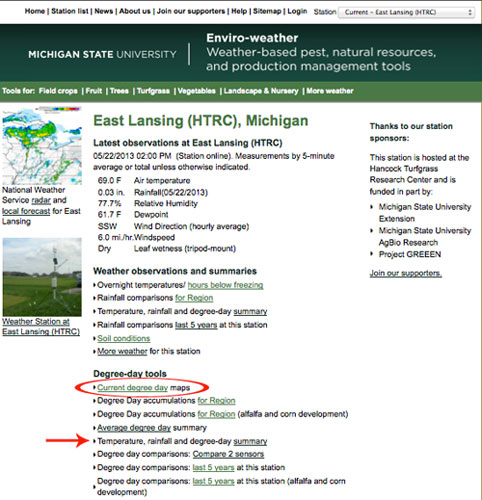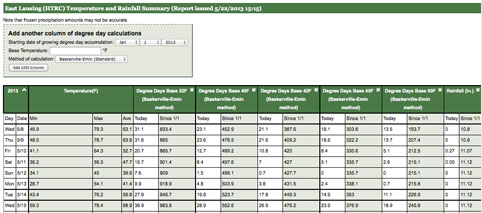Accessing growing degree days with Enviro-weather
Understanding and using accumulated growing degree days can help you know when to expect pests. This is one of the services Enviro-weather offers Michigan growers.
One thing is for sure about Michigan’s weather: it’s always different. Just compare this spring (2013) to last spring. This time last year the season was two weeks or more ahead of normal in most of Michigan. This year, the majority of the state is days or even weeks behind normal.
This variability means that each year the development of crops, weeds, insects and diseases is different. One year the crabapples bloom in late April; another year they are blooming mid-May. This makes it hard to predict when to expect critical events, such as the growth of a crop or the appearance of insects, diseases and weeds. Luckily, we can estimate the relative progress of the growing season using a measure of accumulated heat called growing degree days.
Most living things depend on external temperatures to fuel their growth and development. Unlike birds and mammals, they do not have the ability to generate internal heat and maintain their temperature. This means, for example, that a crabapple tree won’t grow when it is cold. It won’t begin to develop until a minimum temperature is reached (the lower developmental threshold), and the amount and the rate of subsequent growth depends on how warm it is and how long (accumulated heat).
Growing degree days are a way of measuring accumulated heat above a certain temperature threshold (minimum temperature below which development stops). One growing degree day is equivalent to one degree above that temperature threshold for one day. Growing degree days are accumulated, or added, each year beginning either Jan. 1 or March 1.
Both the lower developmental temperature threshold, referred to as the base temperature, and the number of accumulated growing degree days required for a growth stage varies depending on the particular plant or animal. Many insect pests and plants have a lower developmental threshold of near 50 degrees Fahrenheit. Some, however, grow at even lower temperatures, for example 48, 42 and 38 F!
You can find the required growing degree day accumulations for various growth stages of many plants and animals, as well as the lower developmental threshold in various places (for example, see the growing degree days of landscape insects).
You can go to MSU’s Enviro-weather website to check the current growing degree day accumulations for your area. Go to the Enviro-weather website and select a nearby weather station by clicking on the yellow dot that is closest to your station. You will be taken to the “station page” for that location.

Photo 1. East Lansing station page on Enviro-weather.
This page contains a wealth of weather information for that location, including current conditions and weather summaries. It also lists several different growing degree day applications under the heading “Degree-day tools.”
Clicking on the first tool, “Current degree-day maps” (see circle in Photo 1), will take you to a page that displays the current growing degree day totals (base 50 F) throughout Michigan. Additional maps show how far ahead or behind normal we are in terms of growing degree days.
Selecting the “Temperature, rainfall and degree-day summary” tool (see arrow in Photo 1) provides you with a daily summary of temperatures (maximum, minimum and average), rainfall (current day and cumulative) and growing degree days for base 40 F, 42 F, 45 F and 50 F. Growing degree days are given as each day’s accumulation and as the total cumulative growing degree days for the time period. You also have an option of adding another growing degree day column with a different temperature base.

Photo 2. Temperature, rainfall and degree day summary for East
Lansing on Enviro-weather.
Enviro-weather provides a suite of weather-based pest and production management tools online. Enviro-weather is funded by Michigan State University Extension, MSU AgBioResearch, Project GREEEN and private donors.
If you have questions or an idea of how Enviro-weather can help you, please contact Enviro-weather coordinator Beth Bishop at 517-432-6520 or eweather@msu.edu.



 Print
Print Email
Email


